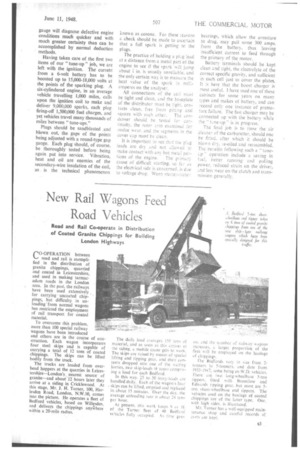New Rail Wagons Feed Road Vehicles
Page 37

If you've noticed an error in this article please click here to report it so we can fix it.
Road and Rail Co-operate in Distribution of Coated Granite Chippings for Building London Highways (-40-OPERATION between road and rail is exemplified in the distribution of granite chippings, quarried and coated in Leicestershire, and used in making tarmacadam roads in the London area. In the past, the railways have been used extensively for carrying uncoated chippings, but difficulty in unloading from normal wagons has restricted the employment of rail transport for coated material.
To overcome this problem, more than 100 special railway wagons have been introduced and others are in the course of construction. Each wagon incorporates four steel skips and is capable of carrying a total of 12 tons of coated chippings. The skips can be lifted bodily from the truck.
The trucks are loaded from overhead hoppers at the quarries in Leicesiershire—London's nearest source of granite—and about 12 hours later they arrive at a siding in CrickIewood. At this stage, Mr. J. H. Turner, 100, Harlesden Road, London, N.W.10, comes into the picture. He operates a fleet of Bedford vehicles, based on Willesden, and delivers the chippings anyilhere within a 20-mile radius.
The daily load its erases 150 tons of material, and as soon as this arrives at the siding, a mobile crane gets to work. The skips are raised by means of special lifting and tipping gear, and their contents dropped into one of the waiting lorries, two skip-loads (.6 tons) comprising a load for each Bedford.
In this way. 25 to 30 lorry-loads are handled daily. Each of the wagons four skips can be lifted, emptied and replaced in about 15 minutes. Over the day. the average unloading rate is about 24 tons per hour.
At present, this work keeps 9 or 10 of the Turner fleet of 48 Bedford vehicles fully occupied. As time goes
onand he number of railway wagons increases, a larger proportion of the fleet will be employed on the haulage of chippings.
The Bedfords vary. in size from 2tonners to 5-tonners. and date from 1933-1947, some being ea-WI). vehicles. There are two long-wheelbase 5-ton tippers, fitted with Bromilow and Edwards tipping gear. but most are 5-ton short-wheelbase end tippers. The vehicles used on the haulage of coated chippings are of the latter type, One, with high sides, is illustrated.
Mr. Turner has a well-equipped main;enance shop and careful records ol." c.o,.ts are kept.




















































































